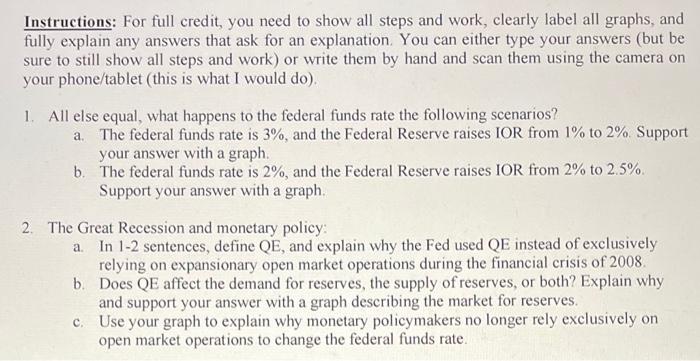Instructions: For full credit, you need to show all steps and work, clearly label all graphs, and fully explain any answers that ask for an explanation. You can either type your answers (but be sure to still show all steps and work) or write them by hand and scan them using the camera on your phone/tablet (this is what I would do). 1. All else equal, what happens to the federal funds rate the following scenarios? a. The federal funds rate is 3%, and the Federal Reserve raises IOR from 1% to 2%. Support your answer with a graph. b. The federal funds rate is 2%, and the Federal Reserve raises IOR from 2% to 2.5%. Support your answer with a graph. 2. The Great Recession and monetary policy: a. In 1-2 sentences, define QE, and explain why the Fed used QE instead of exclusively relying on expansionary open market operations during the financial crisis of 2008 b. Does QE affect the demand for reserves, the supply of reserves, or both? Explain why and support your answer with a graph describing the market for reserves. c. Use your graph to explain why monetary policymakers no longer rely exclusively on open market operations to change the federal funds rate. Instructions: For full credit, you need to show all steps and work, clearly label all graphs, and fully explain any answers that ask for an explanation. You can either type your answers (but be sure to still show all steps and work) or write them by hand and scan them using the camera on your phone/tablet (this is what I would do). 1. All else equal, what happens to the federal funds rate the following scenarios? a. The federal funds rate is 3%, and the Federal Reserve raises IOR from 1% to 2%. Support your answer with a graph. b. The federal funds rate is 2%, and the Federal Reserve raises IOR from 2% to 2.5%. Support your answer with a graph. 2. The Great Recession and monetary policy: a. In 1-2 sentences, define QE, and explain why the Fed used QE instead of exclusively relying on expansionary open market operations during the financial crisis of 2008 b. Does QE affect the demand for reserves, the supply of reserves, or both? Explain why and support your answer with a graph describing the market for reserves. c. Use your graph to explain why monetary policymakers no longer rely exclusively on open market operations to change the federal funds rate







